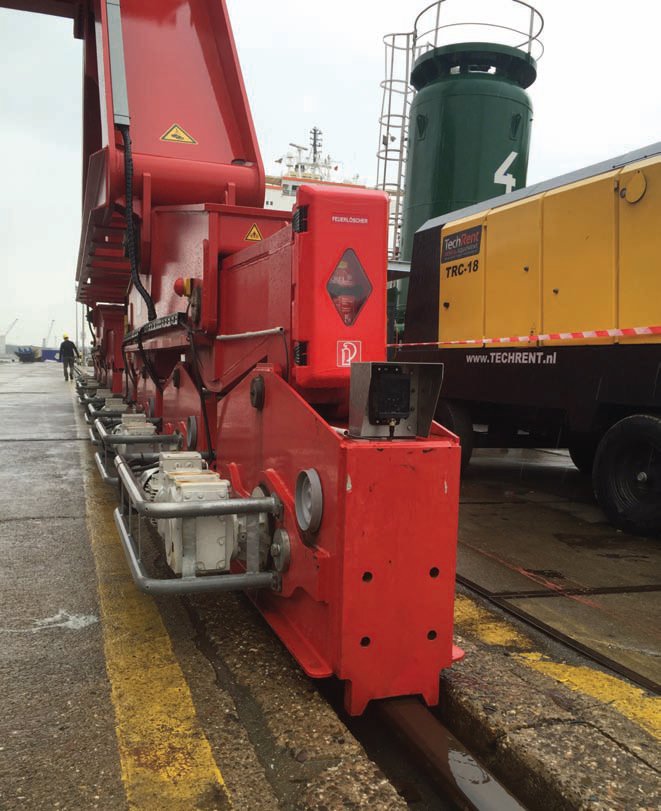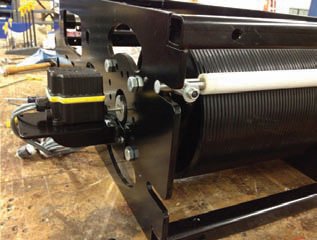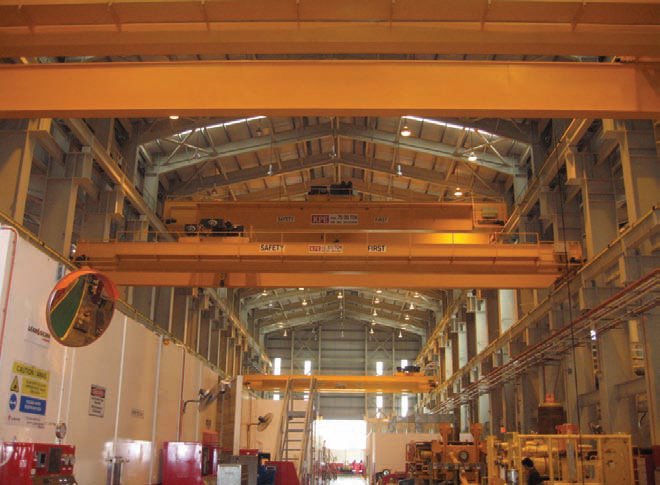Laser guided
29 May 2017Paola De Pascali talked with global sensors manufacturers about the latest anti-collision systems, which are becoming more relevant now as the safety of personnel and equipment is increasing all over the world.
Used to slow down or stop cranes before they come into contact with other objects, laser collision avoidance systems are becoming ever more popular due to the high degree of accuracy and safety that they provide.
“One increasingly common usage of laser technology that is being incorporated into more and more Pelloby overhead and portal cranes over recent years is in anticollision systems,” says Jonathan Ferris, Pelloby marketing manager.
Pelloby recently designed and manufactured a trackless 10t semi-portal crane for BMW’s Mini plant in Swindon, featuring a laser anti-collision system. It was attached to both ends of the lower end carriage, ensuring that the longitudinal travelling motion of the crane is halted in the event of the laser detecting any obstacle, or more importantly any member of staff.
“On several occasions some of our more bespoke lifting systems have incorporated programmable laser scanners as an anticollision feature,” Ferris says. “We have supplied these across various industrial sectors, however a one-of-a-kind inverted travelling jib crane at Rutherford Appleton Laboratories for Oxford is a particularly good example of this. The programmable nature of this laser system means you can predefine ‘slow down’ and ‘stop’ zones of almost any size, shape and complexity up to the limiting range of the device via computer software, and when the scanner encounters an obstacle within this area— the crane will respond accordingly.”
The jib crane at Rutherford Appleton provides 360° rotation and can travel along a 53m gantry railing—however in doing so, it has to pass by a building columns and stanchions. Programmable laser technology helps the crane’s operators negotiate the task, providing a failsafe way to avoid collisions. Pelloby’s remote-controlled floor transporters carrying loads of up to 100t also feature the same programmable laser detection technology as standard. The aim of this system is to provide safer working practices as accidents become less likely, and also to protect the cranes and transporters themselves from becoming damaged in the event of a collision.
“Two Pelloby overhead cranes that were installed at an external London Underground depot in Ruislip took laser technology a step further with special tandem travel positioning sensors,” Ferris says. “These work by measuring the distance between the two crane beams and ensuring it remains constant at all times during tandem lifts where both cranes are being used to handle a single load. Keeping this distance the same maximises stability and ensures the load is evenly supported by both cranes so neither is exceeding its safe work capacity. The system also coordinates the cross travel motion of the hoists along the beams to ensure the load is always lifted as securely as possible.”
Gigasense launched its first anticollision system, the Gigasense Microwave, around 1985. “Since then we delivered our anti-collision systems all over the world, including Australia, China, South-Eastern Asia, Middle East, Germany, Belgium, UK, Sweden, Norway, and North and South America,” says Marie Samuelsson, interim CEO at Gigasense. “Gigasense supplies a fail-safe anti-collision system and collision avoidance system for track bound cranes or similar equipment in tough industrial environment.”
Gigasense engineering manager, Stefan Dalhman says: “This anti-collision system is easy to install, robust, maintenance free and comes with built-in self diagnostic functions to monitor the system. The microwave technology makes it especially suitable for steel-works, harbours and the like environments.”
The main function of Gigasense’s latest anti-collision system the Giga II is to protect two cranes: one crane uses an A-unit and one crane uses a B-unit. A- and B-units each consists of an active antenna and a relay box. The antenna sends a microwave signal to the opposite unit. By using Stepped Frequency Continuous Wave (SFCW) radar, the distance and relative speed are calculated. To protect a crane from a wall or a track end, one transponder without the relay box can be used together with a complete A- or B- unit on the crane.
The output relays switches at preset alarm limits to reduce speed and stop the crane movement. Settings and readout of parameters are easily accessible via a display and push buttons in the relay box. The relay box contains three relays, for warning, speed reduction or flashing light; for stopping the crane movement; and for a failure or unidentified object alarm.
The main benefits for end users are to avoid crane accidents and to protect property, production and people. The signal is very hard to disturb, thanks to the A- and B units using different frequencies, different polarisation of the microwaves and a ‘fingerprint’ radar reflection. The function has a back-up capacitor in case of power failure.
“Our anti-collision system is not disturbed by rain, dust, metal particles, fog or sunlight,” Dalhman. “Operators can use these systems in different speeds or distance. However, our Giga II provides a speed-dependent alarm because the brake of the crane is also very important to make them stop within an alarm distance. So if the speed is higher, the system automatically gives a longer breaking distance.”
Samuelsson adds: “Our main customers are metal industries such as steel and aluminium works. We have also installed these anti-collision systems in container harbours.
“Emirates Steel is one of our long-lasting clients. In 2014 we received the order to equip eight EOT cranes in Abu Dhabi with our anti-collision systems. Our partner in the Middle East, ACE Cranes followed this business.”
The cranes run in a steel mill where the installation work could not be done continuously, and so the work schedule was split to match the mill’s downtime days. This made the installation work span over more than 40 days, even though the installation is very straightforward and does not typically require much time.
“To protect two cranes, the Gigasense anti-collision system contains two units only, where some other systems need four installed units,” says Samuelsson.
SSAB Oxelösund AB has also selected the Gigasense microwave-based anticollision system for their 100t coking plant carriages. As new and stricter environmental regulation comes into force, they will increase the number of anti-collision units. The SSAB Oxelösund Coking Plant was commissioned in 1952 and it is still in operation. Pushing and filling carriages move on rails, filling and emptying the 100 coke ovens respectively. These carriages weigh more than 100t and some even more than 180t. It is most important that they never collide and the process is continuous, taking place every ten minutes.
Today, more than 6,000 Gigasense microwave-based anti-collision systems for cranes and gantries on rails are in use worldwide.
“We usually sell 500 anti-collision systems every year and we have a high demand for digital systems,” says Samuelsson. “For example, it’s possible to connect with a laptop to our system to upgrade systems’ software.”
India-based company SNT Controls and its sister company Speed-O-Controls provide the SOC anti-collision device, which is an upgraded version of the ACD 201. The system works on the principle of retro-reflective infrared waves, comprising of an emitter and receiver module, and a reflector. If the cranes are in proximity, the waves are reflected back to the receiver end of the system, which activates an alarm signal and in turn stops or reduces the speed of the crane. The advanced digital anti-collision system incorporates a microcontroller based circuit for taking digital inputs for easy range setting, and providing an accurate cut-off range to the device. Changes include a four-digit display to adjust sensing distance, a sheet metal body for heavy-duty applications, bigger reflectors, and push buttons instead of potentiometers for regulating sensing distance.
“Such changes have helped our customers set the devices atop the equipment themselves,” says Vineet Yadav, marketing manager at Speed-O-Controls. “The display allows them to adjust the sensing distance themselves between 3 and 10m. The new devices are more precise and accurate and extremely user friendly. “Speed-O-Controls has always focused on cost sensitivity. There are other devices in the market working on infra-red principle, which are far more expensive and can be used only for light- and medium-duty applications.
“We essentially serve heavy equipment and material handling segment. 90% of the business is oriented towards EOT cranes and hoists. Speed-O-Controls has been a pioneer in introducing western technology into India. We have been serving EOT crane customers for over three decades and are currently leading manufacturers of crane spare parts in India.
“Last year SNT Controls supplied our systems to ACC, an Indian cement company, to avoid a collision of wagon loaders, which run on a specific rail system and are connected to a conveyer. The conveyer carries bags filled with cement powder and through an array of processes is then loaded into a goods train. There are usually more than two loaders connected to a specific platform and due to the extreme dust and heat conditions there is a risk of collision.”
Commander Controls design and manufacture collision avoidance systems for X-Y & Z axis applications. For horizontal X-Y applications, there are three system type options, the IRCDS-HSD-II, the Morsonic-II and the MDSμP-II-NB.
The IRCDS-HSD-II Horizontal Crane Detection System for collision avoidance is designed for continuous bi-directional communications to create a high-integrity closed safety loop. Each system requires a partner device on the opposing crane and direction, and cannot be used in a retroreflective stand-alone mode. The system is supplied as an easy-to-install product with plug-in connectivity via fitted ports between hardware components comprising a central interface unit and remote mount transceiver device, which enables bi-directional communication with a partner system.
The system can operate in two directions by adding a plug-in ‘daughter’ PCB and a second transceiver device, to detect and control both forward and reverse directions and speed zones.
“The system is programmed during installation using an installer custom programmer unit, which connects to the mother and daughter PCB,” says William Wood, managing director at Commander Controls. “The input settings are stored in a memory, this prevents any tampering by unauthorised persons after installation set-up. The system can be used at ground level on goliath crane applications to detect stationary obstructions being placed in the path of the crane endcarriage, although the system must not be used for personnel detection as a general rule.”
The Morsonic-II Horizontal Crane Detection System for collision avoidance is designed for stand-alone individual operation in a simplex mode—retroreflective— or to be set to communicate with other systems in a half-duplex mode.
The MDSμP-II-NB Horizontal Crane Detection System for collision avoidance is under re-development, says Wood. The system, which is designed for an independent operation and can be used to detect stationary or moving targets, incorporates the latest Commander development in low-power microwave technology.
The system features a remote mount ‘plug in’ antenna or transceiver with ABS cover to IP65 that enables detection of structural objects such as overhead cranes and building end walls. An optional MDS-Tetrahedron reflector ensures a better return signal from small targets. The system includes three zone relays as standard, which can be programmed during installation for the required detection distances and interfaced to warning devices, directional and speed control circuits.
“For Vertical Z axis applications (all crane/scheme types) we have a single system type, the Commander IRVCD Vertical Crane Detection System for collision avoidance,” says Wood. “This uses security coded infra-red signals to communicate vertically between cranes on two, three or more gantry levels. Upper and lower systems have similar hardware and features, coded where required. All upper crane systems above level 1 incorporate positional hook monitoring, which provides a level of automation to the crane operating performance. When operational, if an upper crane has one or more hooks lowered then this ‘upper’ crane, and any cranes on lower levels that approach the intrusion zone, will be inhibited from bridge forward/reverse travel motion. This means a crane on level 4 will communicate with a crane on level 1, then others as and when they appear within the intrusion zone.”
Amongst the benefits for the end users, Wood explains, these anti-collision systems are software-driven using their own in-house custom-developed software and therefore additional features can be configured if required by the clients. Wood adds: “All user sectors are served wherever overhead cranes, dockside cranes, portal and semi-portal cranes are deployed. We have clients in several applications: overhead factory cranes, heavy engineering cranes, hoist systems, heavy duty steel works, steel distribution warehouse cranes, aircraft production cranes, and aircraft engine production cranes.
“Client crane users do not always have the knowledge to know what they require for such applications and therefore they are not suitably informed by suppliers and installers of the most effective and safe product. “Some firms will supply and install simple retro-reflective optical devices which rely entirely on a progressive reflected signal in the form of reflectors mounted at an angle on the target crane thus to reflect back to the optical emitting device. These systems are not specifically designed for crane applications and therefore are wholly unreliable in performance as they can miss receiving a reflected signal, thus cranes will not then stop and a collision is inevitable with varying consequences to personnel and load and client assets.”
Peter Mertens, managing director at Banner for Europe, Middle East and Africa says collision avoidance is becoming more relevant as demand for the safety of personnel and equipment is increasing. “For a few years now radar technology has been making huge inroads in object detection for collision avoidance,” Mertens says. “The technology is Frequency Modulated Continuous Wave (FMCW); unlike Doppler radars, FMCW radars can detect objects that are either moving or at a standstill, making them ideal for this application.”
Thanks to the use of more integrated circuits and higher gain antennae, the technology has become affordable for more common applications as well. Radar waves are unaffected by weather conditions, making them extremely reliable for outdoor and harsh conditions—with radar sensors currently in use on STS or RTG cranes.
Mertens explains many of Banner’s products are in a continuing product improvement cycle; these can range from small software modifications to major next generation development projects. Specifically for the intermodal market they have focused on radar products, where some older products have been made obsolete and replaced by new enhanced products. “Last year we have released a long range/narrow beam radar that is particularly suited for obstacle detection on fast-moving cranes, looking down narrow corridors between container stacks,” Mertens says. “All of our wireless devices are in the process of re-certification as there is a new Radio Equipment Directive (RED) that will replace the previous directive in June of this year.
“Regarding regulations for wireless devices you have to meet country standards. These standards change constantly and so it’s always a challenge to keep meeting them, to make sure that your products still meet the latest standard. “One of the reasons for success for a global company such as Banner Engineering, is the fact that all of our products comply with international standards. That means that an Original Equipment Manufacturer (OEM) buying our devices doesn’t need to worry if his equipment will still meet the local regulations when he is shipping across the globe.”
One of the fastest growing products for Banner Engineering is indicators and lighting products. “Several years ago a leading spreader manufacturer contacted us because their indicator lights were breaking down frequently, and they were poorly visible for the operators sitting high up in their crane,” Mertens says. “The solution we provided was a specific LED beacon light that is visible from the top and from the sides. The housing is partially epoxy-filled so that it is waterproof and can withstand the heavy shocks when the spreader hits the container. The innovation is in its Pulse Width Modulation dimming capability because it allows the operator to dim the indicator lights during the night-time, but have full illumination during the daytime. Through our partner company Hans Turck GmbH we supplied a special cordset with multiple M12 connectors that make the four or five indicator light installation a ‘plug and play’ set, with reduced margin for error during installation and dramatically reduced downtimes in case of component replacement.”
Chris Aulton, business development manager at Banner Premium Products says the company also offers “reach stacker status”. As skilled operators rarely have to look at the controls, indicators mounted on the boom arm, or other area in the direct line of sight of the operator, are more effective than indicators inside the cab. “This often means that the indicators are best located outside in direct sunlight which can make it difficult to clearly identify the status. Banner daylight visible LED indicators are bright enough to be easily seen in direct sunlight and when the indicator is off they appear grey, as light shining on a coloured lens often makes the indicator appear to be on,” Aulton adds.
sensors and switches
Rotary limit switches can be used everywhere in the crane industry for load positioning, with the most common application for upper and lower limits. Potentiometers and encoders can be also added for precise load monitoring. A position limit switch is another electro-mechanical device that contains a set of contacts triggered by an actuator.
When the limit switch physically comes into contact with an object, this triggers a make-or-break electrical connection in up to eight micro-switches. These are used to monitor crane positions, and more specifically bridge locations. A common install is a ‘slow down and stop’ limit switch for two directions. When the bridge is approaching either end of a runway a limit can be set to warn the operator when it’s getting close, and a secondary limit to fully stop.
Mitch Dahmer, sales and marketing manager of Canadian company Industrial Power and Control, says the company stocks and builds limit switches based on application requirements. “With all the different industries that use limit switches, each job is unique and just about everything is customizable such as revolution ratio, number of contacts and cams, and shaft attachments. We work with the customer to understand the application and then provide the right product with quick turnaround.
“Precision can be absolutely crucial for certain applications and that’s where we start to see encoders coming into play. Absolute or incremental encoders provide the precise position of a load by sending a signal back to the control panel based on the rotations of the switch stack inside the unit. This is used to halt movement resulting in fewer accidents and the misuse of equipment.”
Dahmer explains that these products serve the crane industry, and can be also used for overhead doors, boatlifts, wind turbines and theatre or staging. German producer Siko developed the new redundant absolute rotary encoder WV58MR that allows operators to keep a firm grasp on angles and paths, even under extreme conditions, says the company. The rotary is based on magnetic scanning technology, with the two separated sensor units of the rotary encoder recording positions entirely autonomously. Absolute position and speed are continuously provided to the controls through the interface.
Mathias Roth, branch manager of mobile automation at Siko, says: “Customers can choose from three different versions of interface. In addition to a version with two separate CANopen interfaces, customers can also choose from a version with bus-in bus-out and two node IDs, and one, which reliably transmits via CANopen Safety.
This provides customers full flexibility, allowing them to adjust the encoder to their applications. Whether clients are interested in two separate CAN bus lines or in transmitting reliably through CANopen Safety, the WV58MR offers multiple options.” Siko has recently developed the SGH10 as a measuring system for direct stroke measurement in hydraulic cylinders. The cylinder stroke is measured precisely using wire-actuated sensor technology installed directly in the cylinder.
The wire is mounted in the piston head. If the cylinder is extended, the wire, which is wound up in a wire drum, is pulled out. The rotation of the wire drum that is thereby created is detected without contact by the sensor electronics and used to calculate the linear travel. This makes it possible to detect the position of the cylinder precisely and completely at all times. The magnets that are used to detect the rotation are scanned by the electronics through the pressure-resistant base plate of the SGH10. The electronics are fully encapsulated on the unpressurized side of the system. This means the entire measuring system is built into the cylinder and is optimally protected from external environmental conditions
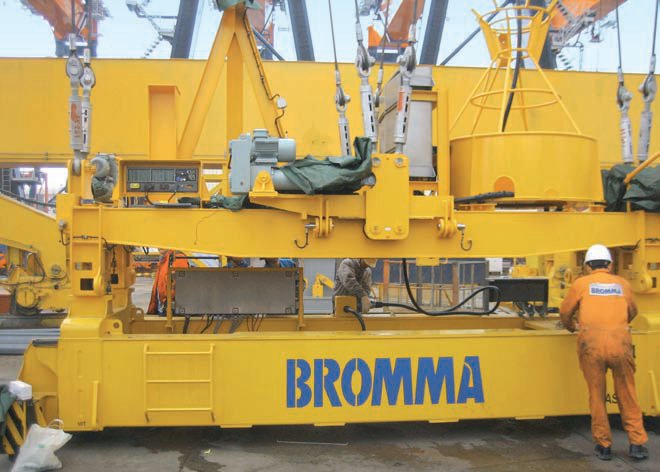 An ABB gantry crane equipped with remote I/O Technology from Turck, which ensures
reliable connections between the field devices and the controller level.
An ABB gantry crane equipped with remote I/O Technology from Turck, which ensures
reliable connections between the field devices and the controller level.
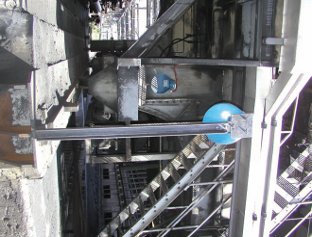 Gigasense GII anti collision system protects track bound equipment in heavy-duty industries worldwide.
Gigasense GII anti collision system protects track bound equipment in heavy-duty industries worldwide.
 SNT Controls and its sister company Speed-O-Controls have recently launched the SOC anti-collision device, which is an upgraded version of the ACD 201.
SNT Controls and its sister company Speed-O-Controls have recently launched the SOC anti-collision device, which is an upgraded version of the ACD 201.
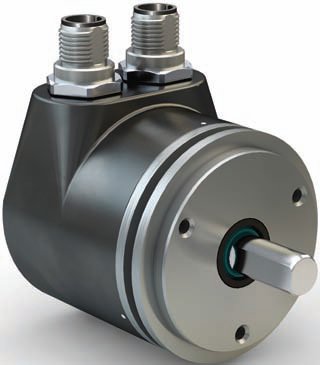 Siko has developed the new redundant absolute rotary encoder WV58MR that allows operators to keep a firm grasp on angles and paths.
Siko has developed the new redundant absolute rotary encoder WV58MR that allows operators to keep a firm grasp on angles and paths.
